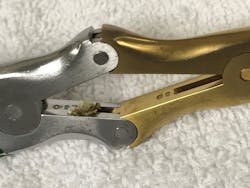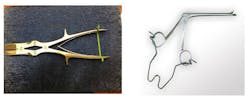Cleaning hinged instruments effectively, anticipating ANSI/AAMI ST 79 updates
Q
We are having a hard time cleaning our double-action bone rongeur. What advice do you have for us?
A
That is an excellent question. The double-action type bone rongeur does offer a significant challenge for cleaning. Stille first developed the double-action bone rongeur around 1872; the “double-action” provides a second hinge point. (See Figure 1) This increases the pressure and force applied to the cutting edges of the rongeur through the lever-action provided by the second pivot point and results in better cutting for the surgeon. The double-action bone rongeur can be found in orthopedic, neurosurgery and plastic surgery instrument trays. While this is an excellent feature for the surgeon, the “double-action” creates a cleaning concern for the medical device reprocessing staff because it can harbor tissue or bone from the surgery, as seen in the picture. (See Figure 2)
Our mantra in Sterile Processing is to refer to the original equipment manufacturer’s (OEM’s) instructions for use (IFU). However, in reviewing many IFUs for this type of surgical instrument, I cannot find specific details on how to keep the rongeur open during the cleaning process or how to inspect at the shanks specifically for lodged tissue or bone during the assembly process. The IFU usually gives us general directions. Here is direction from just one example of an IFU for these types of surgical instruments:
“The cavitation action of ultrasonic cleaners can remove particles of debris from areas of the instrument inaccessible to a brush and is recommended as part of the reprocessing procedure. With the jaws in the open position, place the instrument in a mesh bottom instrument basket. Visually inspect the instrument for cleanliness and clean off any remaining debris. Visually inspect the instrument for damage. Open and close the jaws to ensure proper operation of the instrument.”
The question is how to keep the jaws open during the cleaning process. It is difficult. And we know that if not given the proper tools for our job, the CPD (creative people downstairs) staff, as they are sometimes referred to, will come up with solutions to help solve concerns. (See Figure 3) I have seen inventive measures such as using tongue blades, picks, or anything else to keep the jaws open to allow for the cleaning action to work properly. The cleaning action works to get into the hard-to-reach spots that must stay open during this critical step. One must not forget that pre-cleaning is important, and this area is sometimes overlooked when it comes to proper brushing technique or is never brushed, and this sets up failure.
Many companies provide solutions to keep all types of instruments open during the cleaning process (i.e., adjustable stringer). Exposure to the cleaning process is vital to having clean and functional instruments. You need the proper brushes; that is a given. My other suggestion is to find companies that sell these types of products and provide solutions to help resolve your quest for cleaner double-action bone rongeurs or any other type of hinged instrument that must be kept open during the cleaning process . (See Figure 4)
Q
I have heard that ANSI/AAMI ST 79 has been updated. Is that true?
A
ANSI/AAMI ST 79 was last approved in 2017. Officially, it is on a five-year review process, so it will be around until 2022 when there is another complete document review. Yet, the committee felt there were four significant concerns that needed to be addressed before 2022. (See list below) To my understanding, the results of the changes are to be shared and updated in early 2021, which had not happened yet at press time in early January.
A.1: Amendment for Environmental Services/Fans/Food and Drink.
A.2: Amendment for Inspection of Insulated Instruments.
A.3: Amendment for Modification of Content Pertaining to Frequency of Cleaning for Routine Care of Sterilizers for Sterile Processing Areas in Health Care Facilities.
A.4: Amendment for Content Addressing Recording BI Lot Numbers in Sterilizer Records for Sterile Processing in Health Care Facilities.
Reference
(Rongeurs – Recommended Cleaning, Sterilization, and Instructions for Use) https://www.medline.com/media/mkt/pdf/Rongeurs-IFU.pdf

Stephen M. Kovach
Stephen M Kovach, BS, CFER, started in the medical field in 1975 as a sterilization orderly and has worked in many positions within the Healthcare Industry. He presently is Clinical Educator Emeritus at Healthmark, A Getinge company.









